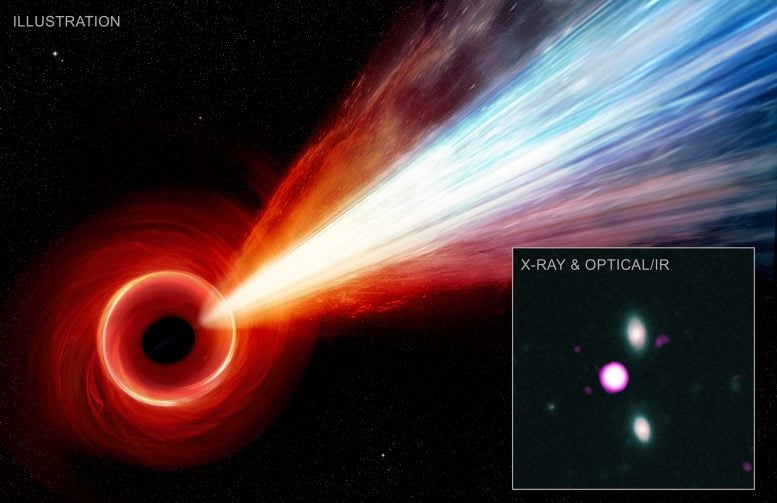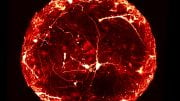
Chandra data may have revealed the most distant known supermassive black hole with an X-ray jet. The source of this jet is a quasar (a rapidly growing black hole) at the center of a young galaxy about 12.7 billion light-years from Earth. The first panel is an artist’s illustration of a close-up view of a quasar and its jet, like the one in PJ352-52. The images show X-ray data from Chandra of PJ352-15, along with optical and infrared data from the Gemini-North telescope and the Keck-I telescope respectively. This result may help explain how the biggest black holes formed at a very early time in the Universe’s history. Credit: X-ray: NASA/CXO/JPL/T. Connor; Optical: Gemini/NOIRLab/NSF/AURA; Infrared: W.M. Keck Observatory; Illustration: NASA/CXC/M.Weiss
Astronomers have discovered evidence for an extraordinarily long jet of particles from a supermassive black hole in the early Universe, using NASA’s Chandra X-ray Observatory.
If confirmed, it would be the most distant supermassive black hole with a jet detected in X-rays, coming from a galaxy about 12.7 billion light-years from Earth. It may help explain how the biggest black holes formed at a very early time in the Universe’s history.
The source of the jet is a quasar — a rapidly growing supermassive black hole — named PSO J352.4034-15.3373 (PJ352-15 for short), which sits at the center of a young galaxy. It is one of the two most powerful quasars detected in radio waves in the first billion years after the Big Bang, and is about a billion times more massive than the Sun.
How are supermassive black holes able to grow so quickly to reach such an enormous mass in this early epoch of the Universe? This is one of the key questions in astronomy today.
Despite their powerful gravity and fearsome reputation, black holes do not inevitably pull in everything that approaches close to them. Material orbiting around a black hole in a disk needs to lose speed and energy before it can fall farther inwards to cross the so-called event horizon, the point of no return. Magnetic fields can cause a braking effect on the disk as they power a jet, which is one key way for material in the disk to lose energy and, therefore, enhance the rate of growth of black holes.
“If a playground merry-go-round is moving too fast, it’s hard for a child to move towards the center, so someone or something needs to slow the ride down,” said Thomas Connor of NASA’s Jet Propulsion Laboratory (JPL) in Pasadena, California, who led the study. “Around supermassive black holes, we think jets can take enough energy away so material can fall inward and the black hole can grow.”
Astronomers needed to observe PJ352-15 for a total of three days using the sharp vision of Chandra to detect evidence for the X-ray jet. X-ray emission was detected about 160,000 light-years away from the quasar along the same direction as much shorter jets seen in radio waves. By comparison, the entire Milky Way spans about 100,000 light-years.
PJ352-15 breaks a couple of different astronomical records. First, the longest jet previously observed from the first billion years after the Big Bang was only about 5,000 light-years in length, corresponding to the radio observations of PJ352-15. Second, PJ352-15 is about 300 million light-years farther away than the most distant X-ray jet recorded before it.
“The length of this jet is significant because it means that the supermassive black hole powering it has been growing for a considerable period of time,” said co-author Eduardo Bañados of the Max Planck Institute for Astronomy (MPIA) in Heidelberg, Germany. “This result underscores how X-ray studies of distant quasars provide a critical way to study the growth of the most distant supermassive black holes.”
The light detected from this jet was emitted when the Universe was only 0.98 billion years old, less than a tenth of its present age. At this point, the intensity of the cosmic microwave background radiation (CMB) left over from the Big Bang was much greater than it is today.
As the electrons in the jet fly away from the black hole at close to the speed of light, they move through and collide with photons making up the CMB radiation, boosting the energy of the photons up into the X-ray range to be detected by Chandra. In this scenario, the X-rays are significantly boosted in brightness compared to radio waves. This agrees with the observation that the large X-ray jet feature has no associated radio emission.
“Our result shows that X-ray observations can be one of the best ways to study quasars with jets in the early Universe,” said co-author Daniel Stern, also of JPL. “Or to put it another way, X-ray observations in the future may be the key to unlocking the secrets of our cosmic past.”
For more on this research, read Massive X-ray Jet – Extending for 160,000 Light-Years – Spied From Supermassive Black Hole in Early Universe.
Reference: “Enhanced X-ray Emission from the Most Radio-Powerful Quasar in the Universe’s First Billion Years” by Thomas Connor, Eduardo Bañados, Daniel Stern, Chris Carilli, Andrew Fabian, Emmanuel Momjian, Sofía Rojas-Ruiz, Roberto Decarli, Emanuele Paolo Farina, Chiara Mazzucchelli and Hannah P. Earnshaw, 23 April 2021, The Astrophysical Journal.
DOI: 10.3847/1538-4357/abe710
arXiv: 2103.03879
A paper describing these results has been accepted for publication in The Astrophysical Journal. The other co-authors of the paper are Chris Carilli (NRAO, Socorro, New Mexico); Andrew Fabian (University of Cambridge, UK); Emmanuel Momjian (NRAO); Sofía Rojas-Ruiz (MPIA); Roberto Decarli (INAF, Bologna, Italy); Emanuele Paolo Farina (Max Planck Institute for Astrophysics, Garching, Germany); Chiara Mazzucchelli (ESO, Chile); Hannah P. Earnshaw (Caltech, Pasadena, California).
NASA’s Marshall Space Flight Center manages the Chandra program. The Smithsonian Astrophysical Observatory’s Chandra X-ray Center controls science from Cambridge Massachusetts and flight operations from Burlington, Massachusetts.









Quasars are the aurora borealis of black holes. They arise due to ionization by rays from the Center of Our Universe. One can only imagine the strong magnetic field of a black hole if the jets go almost vertically.
The magnetic field is not generated by the black hole – as most astronomical objects they neutralize fairly quickly unless a mechanism support charge imbalance – but the magnetic field looks poloidal in fresh results of the Event Horizon Telescope:
https://aasnova.org/2021/03/24/event-horizon-telescope-traces-magnetic-fields-around-a-black-hole/ , last figure.
The universe has – famously – no center, obviously, since it expands everywhere. Nor do you define “rays”. That part of your comment is all pseudoscience.
The link takes you to the paper references, where they do prefer a specific, often mentioned mechanism. Here is the pity Wikipedia description:
“As the ergosphere causes the magnetosphere inside it to rotate, the outgoing flux of angular momentum results in extraction of energy from the black hole.”
[ https://en.wikipedia.org/wiki/Blandford%E2%80%93Znajek_process ]
These are all erroneous theories. And the most important mistake is that a black hole absorbs and does not emit light. The visible spectrum is 10 ^ 14 – 10 ^ 15 Hz. and a black hole at a frequency of 10 ^ 20 Hz holds stars in its orbits, and at a frequency of 10 ^ 32 Hz it itself keeps in orbit around the Center of Our Universe.
Previously, people also thought that we see lightning before we hear thunder because the eyes are closer than the ears)))
very good
VERY GOOD
I knew it was life out there one night I was looking up at the sky at night trying to figure was it a planet or a satellites dish cause the star twinkling so bright than all as once I say a ball of fire traveling from one to next planet warp speed. Scared me cause I thought the planet was going blow up.